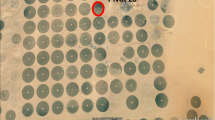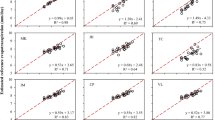Abstract
This research investigates five reference evapotranspiration models (one combined model, one temperature-based model, and three radiation-based models) under hyper-arid environmental conditions at the operational field level. These models were evaluated and calibrated using the weekly water balance of alfalfa by EnviroSCAN to calculate crop evapotranspiration (ETc). Calibration models were evaluated and validated using wheat and potatoes, respectively, on the basis of weekly water balance. Based on the results and discussion, the FAO-56 Penman-Monteith model proved to be superior in estimating ETc with a slight underestimation of 2 %. Meanwhile, the Hargreaves-Samani (HS) model (temperature-based) underestimated ETc by 20 % and the Priestley-Taylor (PT) and Makkink (MK) models (radiation-based) had similar performances underestimating by up to 35 % of the measured ETc. The Turc (TR) model had the lowest performance compared with other models, demonstrating values underestimated by up to 60 % of the measured ETc. Local calibration based on alfalfa evapotranspiration measurements was used to rectify these underestimations. The surprisingly good performance of the calibrated simple HS model, with a new coefficient 0.0029, demonstrated its favorable potential to improve irrigation scheduling. The MK and PT models were in third and fourth rank, respectively, reflecting minor differences between one another. The new coefficients obtained for the MK and PT models were 1.99 and 0.963, respectively. One important observation was that the calibrated TR model performed poorly, with an increase in its coefficient from 0.013 to 0.034 to account for hyper-arid environmental conditions; moreover, it required additional seasonal calibration to adequately improve its performance.








Similar content being viewed by others
References
Adamowski JF (2008) Peak daily water demand forecast modeling using artificial neural networks. J Water Resour Plan Manag 134(2):119–128
Alazba AA, Al-Ghobari HM, Mohammad FS, Alomran AM (2003) Measured and estimated crop ET and Kc for wheat and barley in Central Saudi Arabia. Alex J Agric Res 48(2):1–9
Al-Ghobari HM (2000) Estimation of reference evapotranspiration for southern region of Saudi Arabia. Irrig Sci 19(2):81–86
Allen RG (2003) REF-ET User’s guide. University of Idaho Kimberly Research Stations, Kimberly, Idaho
Allen RG, Pereira LS, Raes D, Smith M (1998) Crop evapotranspiration: guidelines for computing crop water requirements. Food and Agriculture Organization of the United Nations, Rome
Al-Omran AM, Mohammad FS, Al-Ghobari HM, Alazba AA (2004) Determination of evapotranspiration of tomato and squash using lysimeter in Central Saudi Arabia. Int Agric Eng J 13(1&2):27–36
Al-Taher AT, Ahmed A (1992) Estimation of potential evapotranspiration in Al-Hassa oasis, Saudi Arabia. GeoJournal 26(3):371–379
Amatya DM, Skaggs RW, Gregory JD (1995) Comparison of methods for estimating REF-ET. J Irrig Drain Eng 121(6):427–435
Bautista F, Bautista D, Delgdao-Carranza C (2009) Calibration of the equation of Hargreaves and Thornthwaite to estimate the potential evapotranspiration in semi-arid and subhumid tropical climates for regional applications. Atmosfera 22(4):331–348
Benli B, Kodal S, Ilbeyi A, Ustun H (2006) Determination of evapotranspiration and basal crop coefficient of alfalfa with a weighing lysimeter. Agric Water Manag 81(3):358–370
Benli B, Bruggeman A, Oweis T, Ustun H (2010) Performance of Penman-Monteith FAO56 in a semiarid highland environment. J Irrig Drain Eng 136(11):757–765
Berengena J, Gavilan P (2005) Reference evapotranspiration estimation in a highly advective semiarid environment. J Irrig Drain Eng 131(2):147–163
Blaney HF, Criddle WD (1962) Determining consumptive use and irrigation water requirements. U. S. Dept. Agr. Agric Res Serv Tech Bull 1275:59
Buss P (1993) The use of capacitance based measurements of real time soil water profile dynamic for irrigation scheduling. Paper presented at the Irrigation 93 Proceeding of the National Conferences of the Irrigation Association of Australia
Castaneda L, Rao P (2005) Comparison of methods for estimating reference evapotranspiration in Southern California. J Environ Hydrol 13:1–10
Chanasyk DS, Mapfumo E, Willms W (2003) Quantification and simulation of surface runoff from fescue grassland watersheds. Agric Water Manag 59(2):137–153
Debnath S, Adamala S, Raghuwanshi NS (2015) Sensitivity analysis of FAO-56 Penman Monteith method for different agro-ecological regions of India. Environ Process 2:689–704
Dehghani Sanij H, Yamamoto T, Rasiah V (2004) Assessment of evapotranspiration estimation models for use in semi-arid environments. Agric Water Manag 64(2):91–106
Droogers P, Allen RG (2002) Estimating reference evapotranspiration under inaccurate data conditions. Irrig Drain Syst 16(1):33–45
ElNesr M, Alazba AA (2010) Simple statistical equivalents of Penman–Monteith formula’s parameters in the absence of non-basic climatic factors. Arab J Geosci:1–11
ElNesr MN, Alazba AA, Amin MT (2011) Modified Hargreaves’ method as an alternative to the Penman-Monteith method in the kingdom of Saudi Arabia. Aust J Basic Appl Sci 5(6):1058–1069
Farahani HJ, Howell TA, Shuttleworth WJ, Bausch WC (2007) Evapotranspiration: progress in measurement and modeling in agriculture. Trans ASAE 50(5):1627–1638
Gavilán P, Lorite IJ, Tornero S, Berengena J (2006) Regional calibration of Hargreaves equation for estimating reference ET in a semiarid environment. Agric Water Manag 81(3):257–281
Hansen V (1984) Spectral distribution of solar radiation on clear days: a comparison between measurements and model estimates. Clim Appl Meteor 23:772–780
Hargreaves GH, Allen RG (2003) History and evaluation of Hargreaves evapotranspiration equation. J Irrig Drain Eng 129(1):53–63
Hargreaves GH, Samani ZA (1985) Reference crop evapotranspiration from temperature. Appl Eng Agric 1(2):96–99
Igbadun H, Mahoo H, Tarimo A, Salim B (2006) Performance of two temperature-based reference evapotranspiration models in the Mkoji sub-catchment in Tanzania. Agricultural Engineering International: the CIGR Ejournal, Manuscript LW 05 008. Vol. 8
Irmak S, Allen RG, Whitty EB (2003) Daily grass and alfalfa-reference evapotranspiration estimates and alfalfa-to-grass evapotranspiration ratios in Florida. J Irrig Drain Eng 129(5):360–370
Ismail SM (1993) Reference evapotranspiration study in Al-Qassim region. J Agric Sci 5(2):141–151
Jensen ME (1966) Empirical methods of estimating or predicting evapotranspiration using radiation. Paper presented at the Conference on Evapotranspiration and its Role in Water Resources Management, American Society of Agricultural Engineers
Jensen ME, Burman RD, Allen RG (1990) American society of civil engineers. Committee on irrigation water requirements. Evapotranspiration and irrigation water requirements: a manual. The Society, New York
Licciardello F, Zema DA, Zimbone SM, Bingner RL (2007) Runoff and soil erosion evaluation by the AnnAGNPS model in a small Mediterranean watershed. Trans ASAE 50(5):1585–1585
Loague K, Green RE (1991) Statistical and graphical methods for evaluating solute transport models: overview and application. Journal of Contaminant Hydrology JCOHE6, Vol. 7, No. 1/2, p 51–73, January 1991. 7 fig, 5 tab, 20 ref
López-Urrea R, Olalla FMS, Fabeiro C, Moratalla A (2006) An evaluation of two hourly reference evapotranspiration equations for semiarid conditions. Agric Water Manag 86(3):277–282
Makkink GF (1957) Testing the Penman formula by means of lysimeters. J Institut Water Eng 11(3):277–288
Mohammad FS (1997) Calibration of reference evapotranspiration equations for alfalfa under arid climatic conditions. J King Saud Univ Agric Sci 9(1):39–56
Mustafa MA, Akabawi KA, Zoghet MF (1989) Estimation of reference crop evapotranspiration for the life zones of Saudi Arabia. J Arid Environ 17(3):293–300
Nandagiri L, Kovoor GM (2006) Performance evaluation of reference evapotranspiration equations across a range of Indian climates. J Irrig Drain Eng 132(3):238–249
Penman HL (1948) Natural evaporation from open water, bare soil and grass. Proc R Soc Lond A Math Phys Sci 193(1032):120–145
Priestley CHB, Taylor RJ (1972) On the assessment of surface heat flux and evaporation using large-scale parameters. Mon Weather Rev 100(2):81–92
Razzaghi F, Sepaskhah AR (2011) Calibration and validation of four common ETo estimation equations by lysimeter data in a semi-arid environment. Arch Agron Soil Sci 58(3):303–319
Saeed M (1988) Simple equations for estimating reference evapotranspiration in an arid climate, Saudi Arabia. Arab Gulf J Sci Res 6(3):325–338
Stannard DI (1993) Comparison of Penman-Monteith, Shuttleworth-Wallace, and modified Priestley-Taylor evapotranspiration models for wildland vegetation in semiarid rangeland. Water Resour Manag 29(5):1379–1392
Suleiman AA, Hoogenboom G (2007) Comparison of Priestley-Taylor and FAO-56 Penman-Monteith for daily reference evapotranspiration estimation in Georgia. J Irrig Drain Eng 133(2):175–182
Tabari H (2010) Evaluation of reference crop evapotranspiration equations in various climates. Water Resour Manag 24(10):2311–2337
Tabari H, Talaee PH (2011) Local calibration of the Hargreaves and Priestley-Taylor equations for estimating reference evapotranspiration in arid and cold climates of Iran based on the Penman-Monteith model. J Hydrol Eng 16(10):837–845
Temesgen B, Allen RG, Jensen DT (1999) Adjusting temperature parameters to reflect well-watered conditions. J Irrig Drain Eng 125(1):26–33
Thornthwaite CW (1948) An approach toward a rational classification of climate. Geogr Rev 38(5):55–94
Trajković S, Gocić M (2010) Comparison of some empirical equations for estimating daily reference evapotranspiration. Arch Civ Eng 8(2):163–168
Turc L (1961) Estimation of irrigation water requirements, potential evapotranspiration: a simple climatic formula evolved up to date. J Ann Agron 12:13–14
Xu CY, Chen D (2005) Comparison of seven models for estimation of evapotranspiration and groundwater recharge using lysimeter measurement data in Germany. Hydrol Process 19:3717–3734
Xu CY, Singh VP (2002) Cross comparison of empirical equations for calculating potential evapotranspiration with data from Switzerland. Water Resour Manag 16(3):197–219
Yoder RE, Odhiambo LO, Wright WC (2005) Evaluation of methods for estimating daily reference crop evapotranspiration at a site in the humid Southeast United States. Appl Eng Agric 21(2):197–202
Acknowledgments
With sincere respect and gratitude, we express deep thanks to the Deanship of Scientific Research, King Saud University and Agriculture Research Center, College of Food and Agriculture Sciences, for financial support, sponsorship and encouragement.
Author information
Authors and Affiliations
Corresponding author
Rights and permissions
About this article
Cite this article
Mattar, M.A., Alazba, A.A., Alblewi, B. et al. Evaluating and Calibrating Reference Evapotranspiration Models Using Water Balance under Hyper-Arid Environment. Water Resour Manage 30, 3745–3767 (2016). https://doi.org/10.1007/s11269-016-1382-y
Received:
Accepted:
Published:
Issue Date:
DOI: https://doi.org/10.1007/s11269-016-1382-y




